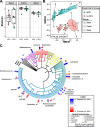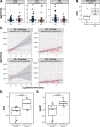IL-22 alters gut microbiota composition and function to increase aryl hydrocarbon receptor activity in mice and humans
- PMID: 36894983
- PMCID: PMC9997005
- DOI: 10.1186/s40168-023-01486-1
IL-22 alters gut microbiota composition and function to increase aryl hydrocarbon receptor activity in mice and humans
Abstract
Background: IL-22 is induced by aryl hydrocarbon receptor (AhR) signaling and plays a critical role in gastrointestinal barrier function through effects on antimicrobial protein production, mucus secretion, and epithelial cell differentiation and proliferation, giving it the potential to modulate the microbiome through these direct and indirect effects. Furthermore, the microbiome can in turn influence IL-22 production through the synthesis of L-tryptophan (L-Trp)-derived AhR ligands, creating the prospect of a host-microbiome feedback loop. We evaluated the impact IL-22 may have on the gut microbiome and its ability to activate host AhR signaling by observing changes in gut microbiome composition, function, and AhR ligand production following exogenous IL-22 treatment in both mice and humans.
Results: Microbiome alterations were observed across the gastrointestinal tract of IL-22-treated mice, accompanied by an increased microbial functional capacity for L-Trp metabolism. Bacterially derived indole derivatives were increased in stool from IL-22-treated mice and correlated with increased fecal AhR activity. In humans, reduced fecal concentrations of indole derivatives in ulcerative colitis (UC) patients compared to healthy volunteers were accompanied by a trend towards reduced fecal AhR activity. Following exogenous IL-22 treatment in UC patients, both fecal AhR activity and concentrations of indole derivatives increased over time compared to placebo-treated UC patients.
Conclusions: Overall, our findings indicate IL-22 shapes gut microbiome composition and function, which leads to increased AhR signaling and suggests exogenous IL-22 modulation of the microbiome may have functional significance in a disease setting. Video Abstract.
Keywords: Aryl hydrocarbon receptor; Colitis; Gastrointestinal microbiome; IL-22; Indole; Inflammatory bowel disease; Tryptophan.
© 2023. The Author(s).
Conflict of interest statement
JSM, NO, YP, AJ, DS, ES, ANL, MR, MWT, and MK are employees of Genentech, Inc. NDP and TY are former employees of Genentech, Inc.
Figures




References
Publication types
MeSH terms
Substances
LinkOut - more resources
Full Text Sources
Molecular Biology Databases
Research Materials

